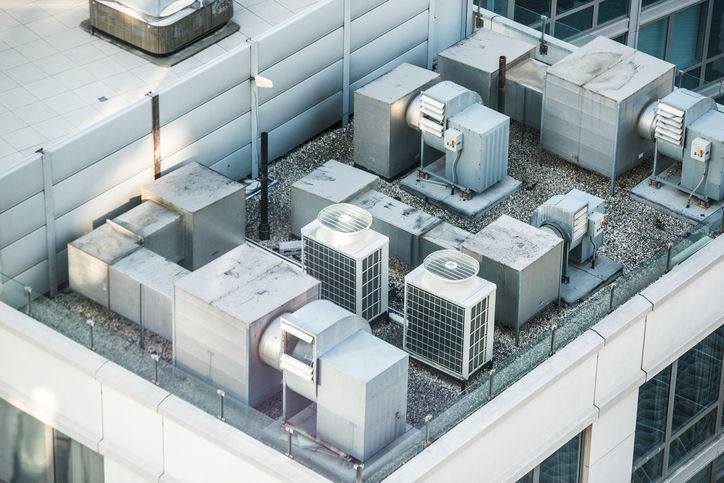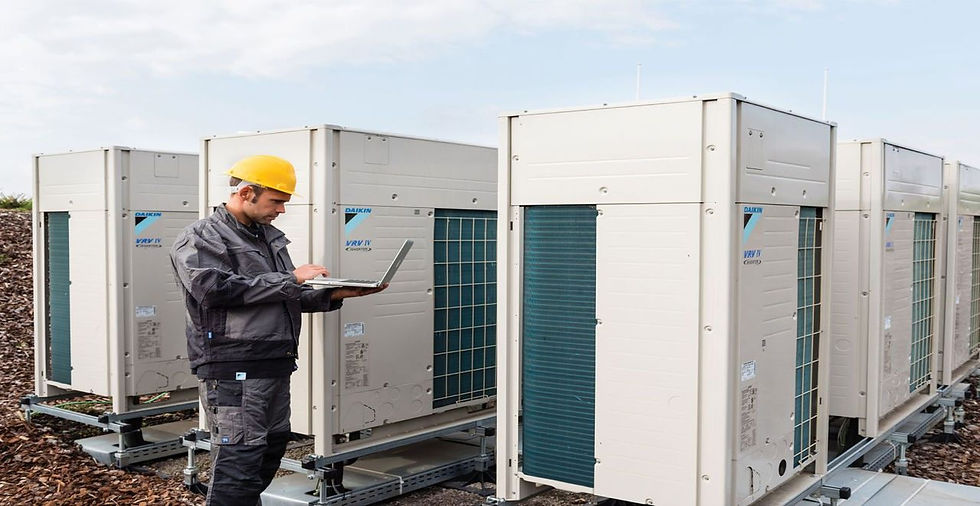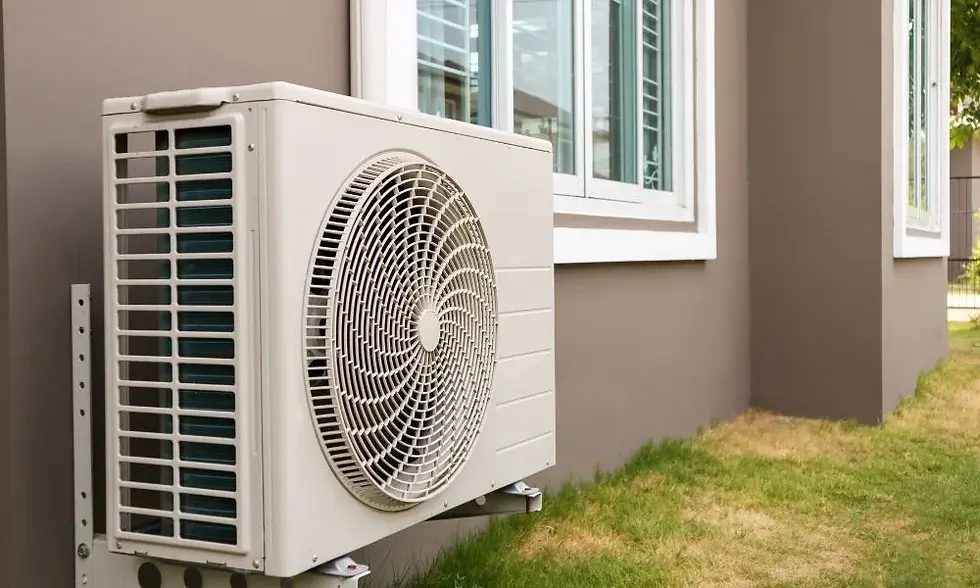
HVAC Technologies: Ensuring Guest Comfort & Operational Efficiency
In the hospitality industry, encompassing motels, hotels, resorts, and casinos, the guest experience is paramount. Whether it’s a boutique motel or a sprawling casino resort, maintaining a comfortable, inviting environment is critical to earning positive reviews and repeat business. HVAC systems account for 40–80% of a hotel’s energy consumption, making them a significant operational and financial consideration. Hospitality properties must balance guest comfort with operational efficiency. Guests expect personalized climate control in rooms, seamless cooling in public areas like lobbies and restaurants, and consistent air quality to ensure health and safety.
Top 5 HVAC Systems for the Hospitality Industry
We specialize in a full range of HVAC services, tailored to meet the unique needs of your home or business.
Packaged Terminal Air Conditioners (PTAC) in the Hospitality Industry
Packaged Terminal Air Conditioners (PTACs) are self-contained HVAC units designed for through-the-wall installation, typically under windows, to provide heating and cooling for individual rooms. These compact systems house a compressor, evaporator, condenser, and control panel within a single unit, eliminating the need for ductwork. Widely adopted in budget motels, small hotels, and mid-tier hospitality properties, PTACs offer a cost-effective, reliable solution for room-specific climate control. Modern PTACs, such as the Gree ETAC 2 with an Energy Efficiency Ratio (EER) of 11.6, incorporate advanced technologies like low-GWP refrigerants and smart thermostats, ensuring compliance with ASHRAE standards and environmental regulations while meeting the hospitality industry’s demand for guest comfort and operational efficiency.
In the hospitality sector, PTACs are valued for their affordability and simplicity. Installation costs range from $700 to $1,500 per unit, significantly lower than ducted systems, making them ideal for budget-conscious properties or retrofits. Guests enjoy individualized temperature control, enhancing satisfaction and supporting positive reviews, which are critical for repeat business. Maintenance is streamlined, with easily accessible components reducing service downtime and costs, a key advantage for properties with limited staff. Energy-efficient models lower utility bills, aligning with sustainability goals and qualifying for rebates under programs like the Inflation Reduction Act, further improving return on investment.
Best Use: PTACs are ideal for budget motels and small hotels seeking cost-effective, room-specific climate control that prioritizes guest comfort and operational simplicity.

Advantages:
Cost-Effective Installation: PTACs require no ductwork, reducing installation costs and complexity, ideal for single-room applications.
Individual Control: Guests can adjust room temperatures, enhancing comfort and satisfaction.
Ease of Maintenance: PTACs are straightforward to service and replace, minimizing downtime and costs.
Energy Efficiency: Modern PTACs offer improved efficiency, reducing energy costs and supporting sustainability.
Disadvantages:
Noise: Older PTACs can be noisy, potentially disturbing guests, though newer models are quieter.
Limited Coverage: PTACs serve only one room, requiring multiple units for larger properties, increasing initial costs.
Aesthetics: Visible units may detract from room design, especially in luxury hotels.

Vertical Terminal Air Conditioners (VTAC) in the Hospitality Industry
Vertical Terminal Air Conditioners (VTACs) are compact, through-the-wall HVAC systems designed for installation in closets or corners, often with ductwork to serve multiple rooms or zones within a hospitality setting. Unlike PTACs, which are limited to single-room applications, VTACs are engineered to provide efficient heating and cooling for multi-room suites, bathrooms, or adjacent areas, making them a preferred choice for mid-tier hotels, resorts, and boutique properties. VTACs integrate compressors, evaporators, and advanced controls within a single unit, offering a balance of performance and discretion. Modern VTACs incorporate energy-efficient technologies, such as variable-speed compressors and low-GWP refrigerants, ensuring compliance with ASHRAE standards and environmental regulations like the AIM Act. Their concealed design and quiet operation cater to the hospitality industry’s need for guest comfort and aesthetic appeal, particularly in properties prioritizing a premium experience.
In hospitality, VTACs excel by delivering flexible climate control for multi-room configurations. They can cool or heat interconnected spaces, such as suites with living areas and bedrooms, improving energy efficiency by reducing the need for multiple units. Their hidden installation enhances room aesthetics, appealing to upscale properties. Commercial-grade construction ensures durability, handling the demands of continuous operation in hotels or resorts. However, higher upfront costs and maintenance challenges require careful financial planning.
Best Use: VTACs are ideal for mid-tier hotels or resorts with suites requiring quiet, multi-zone climate control while maintaining aesthetic appeal.
Advantages:
Quiet Operation: Concealed in closets or corners, VTACs operate at lower noise levels than PTACs, enhancing guest comfort in hospitality settings.
Multi-Room Capability: Ducted VTACs efficiently cool or heat multiple areas, ideal for suites or interconnected spaces.
Aesthetic Appeal: Hidden design preserves room aesthetics, suitable for mid-tier and upscale hotels.
Reliability: Commercial-grade build ensures long-term durability under high-demand conditions.
Disadvantages:
Higher Costs: VTACs, priced at $1,500–$3,000 per unit, plus ductwork, have higher installation costs than PTACs.
Maintenance Access: Concealed units are harder to service, potentially increasing maintenance expenses.
Space Requirements: Dedicated closets or corners reduce usable floor space.
Variable Refrigerant Flow (VRF) Systems in the Hospitality Industry
Variable Refrigerant Flow (VRF) systems are advanced HVAC solutions that utilize a single outdoor condenser unit connected to multiple indoor fan coil units, enabling simultaneous heating and cooling across different zones within a building. Designed for large-scale hospitality properties such as hotels, resorts, and casinos, VRF systems modulate refrigerant flow based on real-time demand, offering precise temperature control for diverse spaces like guest rooms, lobbies, conference halls, and spas. These systems incorporate cutting-edge technologies, such as inverter-driven compressors and low-GWP refrigerants (e.g., R-32), ensuring compliance with ASHRAE Standard 90.1 and environmental regulations like the AIM Act. VRF systems integrate seamlessly with building automation systems (BAS), allowing centralized monitoring and optimization, which is critical for managing energy use in high-occupancy hospitality environments. Their ability to provide individualized climate control enhances guest satisfaction while reducing energy waste, making them a cornerstone for modern hospitality facilities aiming for efficiency and comfort.
In the hospitality industry, VRF systems are prized for their flexibility and performance. They support zoned climate control, allowing guests to adjust room temperatures independently while public areas maintain consistent conditions. Their quiet operation and high energy efficiency make them ideal for luxury settings. However, high installation costs and specialized maintenance needs require strategic financial planning.
Best Use: Best Use: VRF systems are perfect for large hotels, resorts, or casinos needing flexible, efficient climate control across multiple zones.

Advantages:
Energy Efficiency: VRFs achieve SEER ratings up to 30, reducing energy costs by up to 30% compared to traditional systems, ideal for high-usage hospitality settings.
Quiet Operation: Outdoor condensers minimize indoor noise, ensuring guest comfort in rooms and spas.
Zoning Flexibility: Individual control for each room or zone enhances guest satisfaction and operational efficiency.
Heat Recovery: VRFs with heat recovery redirect heat between rooms, boosting energy savings.
Disadvantages:
High Initial Costs: Installation, requiring skilled technicians, is significantly more expensive than PTACs or VTACs.
Complex Maintenance: Repairs demand specialized expertise, increasing long-term costs.
Space for Outdoor Units: Large condensers require roof or ground space, which may be limited in some properties.
Central HVAC Systems (Multi-Split Systems) in the Hospitality Industry
Central HVAC systems, also known as multi-split systems, are robust solutions designed to provide heating, ventilation, and air conditioning across entire buildings through a centralized unit connected to extensive ductwork. These systems are ideal for large hospitality properties, such as corporate hotels, resorts, and casinos, where consistent climate control is needed across diverse spaces like guest rooms, lobbies, restaurants, and conference centers. Central HVAC systems incorporate advanced components, including chillers, boilers, air handlers, and high-efficiency filters, to deliver uniform temperature and superior indoor air quality (IAQ). Integration with building automation systems (BAS) enables real-time monitoring and control, optimizing energy use and ensuring compliance with industry standards like ASHRAE 90.1 and low-GWP refrigerant regulations (e.g., AIM Act). By leveraging smart controls and variable-speed technology, central systems can adjust to fluctuating occupancy, making them a scalable choice for hospitality venues with high-traffic areas and expansion plans. Their ability to maintain consistent environments enhances guest comfort and operational efficiency, critical for large-scale properties.
In the hospitality industry, central HVAC systems excel in managing complex climate needs. They ensure seamless comfort across large spaces while supporting sustainability through efficient operation. However, high installation and maintenance costs require careful financial planning.
Best Use: Central HVAC systems are best for large resorts or corporate hotels with high occupancy and diverse spaces requiring uniform climate control and scalability.

Advantages:
Whole-Building Coverage: Ideal for large hotels or casinos, providing consistent climate control across rooms, lobbies, and restaurants.
Advanced Control: Integration with BAS allows centralized management, optimizing energy use and guest comfort.
Air Quality: Enhanced filtration and ventilation improve IAQ, critical for high-occupancy spaces like banquet halls.
Scalability: Suitable for properties with future expansion plans, accommodating additional zones.
Disadvantages:
High Installation Costs: Extensive ductwork and complex setup increase upfront expenses, often $50,000 or more.
Maintenance Complexity: Central systems require professional servicing, raising long-term costs.
Energy Loss: Duct leaks can reduce efficiency by up to 20% if not properly maintained.

Central HVAC Systems (Mini-Split Systems) in the Hospitality Industry
Mini-split systems, also known as ductless HVAC systems, consist of an outdoor condenser unit connected to one or more indoor units, delivering targeted heating and cooling for individual rooms or small zones. Designed for flexibility, these systems are ideal for boutique hotels, motels, and smaller hospitality properties where ductwork is impractical or cost-prohibitive. Indoor units, available as wall-mounted, ceiling cassette, or floor-mounted models, provide discreet climate control, blending seamlessly with room aesthetics. Mini-splits utilize advanced technologies, such as inverter-driven compressors and low-GWP refrigerants like R-32, achieving SEER ratings up to 30 for exceptional energy efficiency. Compliant with ASHRAE standards and regulations like the AIM Act, they integrate with smart thermostats and building automation systems (BAS) for precise control, ensuring guest comfort while minimizing energy waste. Their ductless design simplifies installation and maintenance, making them a cost-effective choice for properties prioritizing efficiency and guest satisfaction in smaller spaces.
In the hospitality industry, mini-splits offer tailored climate solutions for individual rooms, enhancing guest experiences through quiet operation and energy savings. However, their limited coverage and aesthetic considerations require strategic planning for larger properties.
Best Use: Mini-splits are ideal for boutique hotels or motels needing quiet, efficient cooling and heating for individual rooms or small zones.
Advantages:
Energy Efficiency: SEER ratings up to 30 reduce energy costs by up to 30%, ideal for budget-conscious hospitality properties.
Quiet Operation: Indoor units operate at 17 dB, quieter than a whisper, ensuring guest comfort in rooms or quiet zones.
Flexible Installation: Wall-mounted or ceiling cassette units save space and blend with room design, ideal for renovations.
Low Maintenance: Ductless design simplifies servicing, reducing costs compared to central systems.
Disadvantages:
Limited Coverage: Best for single rooms or small zones, requiring multiple units for larger properties, increasing costs.
Upfront Costs: More expensive than PTACs ($2,000–$4,000 per unit), though less than VRF systems.
Aesthetic Impact: Visible indoor units may affect luxury aesthetics in high-end hotels.

Technology and Solutions for Optimal Performance
Tailored technologies address the unique needs of each food and beverage setting:
Increased Energy Bills: Inefficient systems consume more power, inflating utility costs unnoticed until budgets are strained.
Maintenance Expenses: Aging equipment requires frequent repairs, diverting resources from growth initiatives.
Downtime: System failures disrupt operations, leading to lost revenue and customer dissatisfaction.
Health and Safety Risks: Grease buildup in kitchen exhaust systems or poor ventilation can violate codes, risking fines or closures.
Reduced Equipment Lifespan: Overworked systems fail sooner, necessitating costly replacements.

Navigating Regulations and Sustainability
The food and beverage industry faces stringent regulations, including IMC, NFPA 96, and ASHRAE standards, governing ventilation hoods for commercial kitchens and exhaust systems. Compliance ensures safety and avoids penalties but can strain aging systems. Sustainability regulations, such as energy efficiency mandates, further complicate operations. For example, the Energy Standards limit short-circuit hoods to 10% replacement air to reduce energy waste.
Upgrading to energy-efficient commercial ventilation systems and kitchen exhaust systems aligns with these regulations while reducing invisible costs. Financial incentives, like tax credits for energy-efficient equipment, offset upgrade expenses. Businesses can also explore leasing options to manage capital expenditures, ensuring compliance without financial strain.



.png)